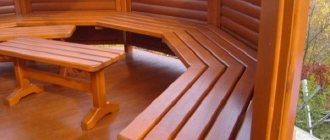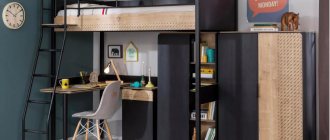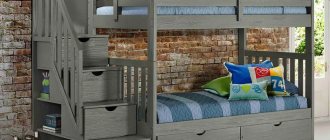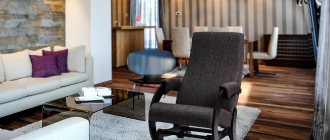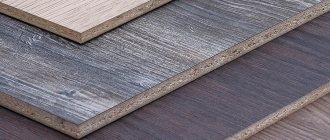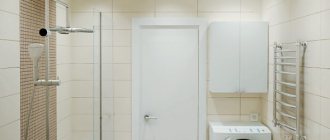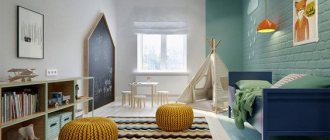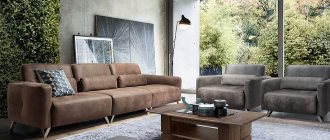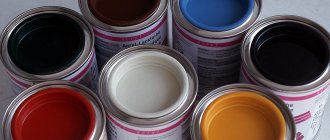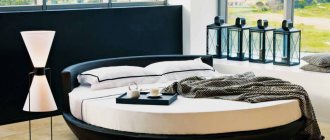Selection and preparation of raw materials for independent weaving
To make wicker furniture with your own hands, blanks from a variety of materials can be used. Each of them has its own pros and cons. The choice depends on personal preference.
| Name of raw materials for wicker furniture | Advantages | Possible disadvantages or limitations |
| Willow twigs (cut branches of willow, willow, willow, willow) | Flexibility, availability, ability to use blanks with different thicknesses | Risks of cracking, increased by improper preparation of rods, fragility. Length is often limited to 50 cm |
| Hazel twigs | Good combination of strength and durability, length can reach 9m | Rigidity |
| Bird cherry twigs | Unique elasticity | Material is hard to find |
| Bamboo | Decorative, light, hard | Rigidity, the need for heating to obtain bending |
| Birch bark strips up to 20–40 mm wide | Beautiful shade | Difficult preparation stage, risks of drying out, average strength indicators |
| The roots of coniferous trees are from 1 to 3 cm thick | Durable, comfortable length | Loss of color and elasticity due to improper preparation |
| Rattan | Possibility of creating frameless wicker furniture, unique strength | Fading in the sun and the high cost of natural raw materials |
| Lake reed growing in the southern regions of the Russian Federation | Ideal for complex or openwork weaving | Not suitable for frame furniture structures |
| Abaca (banana leaves from 75 cm long) | Beautiful natural color, lightness, strength | Expensive |
| water hyacinth | Moisture resistance, flexibility, softness, silkiness | Labor-intensive, time-consuming preparation technology |
| Seaweed | Spectacular look | Low strength |
| Newspaper tubes (paper vine) | Cheapness, simplicity | To manufacture loaded elements, high-density tubes are needed, lengthy preparation |
Plastic bird cherry, alder or willow are considered suitable raw materials for beginners. To attract children's interest or use complex patterns, newspaper tubes are best.
Exotic materials (banana leaves, water hyacinth, seaweed, bamboo) are difficult to obtain, and it is not advisable to gain experience in weaving furniture with their help.
Seaweed
Bamboo
Willow twigs
Birch bark strips
Materials suitable for weaving
The manufacture of wicker furniture can be carried out using various materials. The main requirement for them is high flexibility and durability. The most commonly used materials are:
- banana leaves - they are up to 350 cm long and highly durable. This material is considered suitable not only for creating various unique and unusual furniture, but also for producing a variety of ropes or ropes. It is lightweight, and furniture made from the material has a dark brown color;
- bamboo - it is considered quite tough, so it is rarely used by novice craftsmen. It is difficult to obtain any specific products from this material. Bamboo shavings are usually used, which are effectively used to obtain unique decorative elements;
- rattan - any wicker product made from this material is distinguished by its sophistication. Weaving a willow hedge for beginners step by step? It is considered easy to use, inexpensive and makes it possible to obtain original furniture. The production of various designs is considered so simple that it is accessible to every person. The resulting products are durable and also resistant to moisture;
- willow - weaving furniture from willow is a popular procedure, since this material is chosen most often. It has good strength and excellent flexibility. The disadvantages of willow construction include its tendency to crack, which significantly spoils its appearance, and it is almost impossible to correct this drawback. Also, the rods are considered quite rigid, so difficulties often arise when bending them;
- paper - it is not used to create any interior or exterior items, but weaving from newspaper tubes or plain paper is considered popular. It allows you to make furniture for dolls or various decorative elements that fit perfectly into a variety of interior styles.
Having figured out what furniture is woven from, you can begin the actual weaving process.
Required Tools
When making frames and solid wooden elements, you will need a separate set of tools: saw, hacksaw, chisels. Making wicker furniture is simplified by having a stable table with drawers and a board for holding workpieces, securely fixed to the tabletop. Hoops, side ribs or other patterns must be selected in advance, taking into account their future hiding in the furniture being manufactured.
To prepare the material you need:
- tools for cutting workpieces: knives (garden, humpback, sickle, basket), pruning shears;
- containers for soaking rods (when making wicker furniture from willow with your own hands in large quantities, vats for painting and cauldrons for cooking blanks are added to them);
- pinches for removing bark, cleavers for splitting workpieces;
- pliers for holding rods.
All these tools will not be needed if you purchase ready-made raw materials.
Also in the weaving process, measuring accessories, templates, a beater (iser) for compacting the weave or leveling rows, and a jamka - a flat wrench for bending thick rods or straightening workpieces - can be useful.
Step-by-step launch instructions
From writing a business plan for production to selling the first batch of finished furniture, 7 consecutive steps should be taken:
- Opening an individual entrepreneur . It is necessary to register a legal entity with a simplified taxation system. If raw materials are procured independently, then it is beneficial to use the “Revenues 6%” system, and when purchasing materials – “Revenues minus expenses 15%”.
- Renting premises. For preparing the material and weaving, a room with an area of 10 square meters, dry, clean, heated, with a water supply and sewage system is suitable. If the size of the home workshop is insufficient, some processes can be performed under a canopy, for example, boiling down twigs in bathtubs and peeling bark. With a full production cycle, it is necessary to provide a place for storing raw materials and a drying workshop for products.
- Procurement or purchase of raw materials. In production, sticks 100 cm long are used as a frame and vines 2 m long for weaving. They are stored and purchased in bundles of 100 pieces; during transportation, it is not advisable to bend the rods and expose them to moisture.
- Purchase of equipment. The weaver's workplace is equipped with a workbench, a comfortable chair, and a box for storing tools. Electrical equipment: drill, jigsaw, screwdriver and consumables for them are purchased in electrical goods stores, hand tools: pruners, knives, scissors - in departments for gardeners, but special tools for wicker weaving are practically not offered for sale. It is made independently on a lathe or ordered to be manufactured according to drawings and diagrams that can be found in textbooks and the Internet.
- Purchase of consumables. If the production cycle provides for subsequent processing of finished products, then it is necessary to purchase stains, varnishes of various shades, and anti-moisture treatment compounds. The entire range of consumables for processing vines is presented at construction wholesale stores.
- Production . Making wicker furniture yourself takes several days, depending on the size and complexity of the design. For example, in a week you can make two rocking chairs or three simple benches. To increase production volumes, it will be necessary to find and train personnel, additional costs for taxes and premises for storing finished products.
- Marketing and sales. The first steps in selling ready-made furniture are the creation of a high-quality business card website, printed catalogs, advertising brochures offering the production of unique items to order. When expanding production, it is possible to conclude contracts for wholesale supplies to furniture stores, and work on order with design bureaus. Entrepreneurs who manufacture products for children must obtain a quality certificate for the product before concluding a sales contract.
Features of wicker furniture
The history of wicker furniture goes back thousands of years. Archaeologists often find it all over the world. Weaving from vines and other natural materials of plant origin was common in settlements located near bodies of water. The proximity of suitable raw materials in large quantities contributed to the fact that people made most of the products used in everyday life on their own.
Wicker furniture was used more often in the homes of the poor, as the cheapest and most accessible option. But quite quickly wealthy people and representatives of the nobility appreciated its beauty, functionality and possibilities of use in the interior. Since then, not only single craftsmen, but also entire artels, and later factories, have been engaged in weaving. There are even special schools of wicker weaving.
Prince Golitsyn brought the fashion for wicker furniture to Russia. Often traveling abroad, he appreciated the properties of wicker products and created an entire workshop for their production on his estate.
Wicker furniture can be a real work of art
Nowadays wicker furniture is very popular. Making it becomes a favorite hobby for many, even generating income. In addition, it has many advantages. These include:
- low cost, especially compared to products made from other natural materials;
- light weight, thanks to which you can easily move the furniture anywhere without outside help;
- environmental friendliness: wicker interior items not only look beautiful, but are also safe for health and do not have a specific odor;
- easy care: most often it is enough to wipe off dust from the furniture with a cloth dipped in water;
- durability, subject to high-quality weaving, performed according to all the rules.
True, there are also disadvantages that need to be taken into account. Furniture woven from wicker and similar materials is not resistant to the vagaries of the weather. In heavy rain it gets wet, and with prolonged exposure to sunlight and high temperatures it can dry out. This leads to loss of shape and disruption of the weave. Repairing a damaged product is very difficult. Therefore, it is not recommended to keep such furniture in open areas for a long time.
Nowadays wicker furniture is very popular, and many people are starting to make it at a professional level.
According to the structure and manufacturing principle, wicker furniture is divided into several types:
- Frameless products. In them, the rigidity of the structure is ensured by strong stick-ribs.
- Frame furniture, in which the body is made of durable material, such as steel rods. The metal parts of the frame are braided with wicker or other appropriate material.
- Wooden furniture in which the supporting frame is made of wooden sticks that impart rigidity and durability.
Advantages of wicker furniture
Weaving pieces of furniture from willow with your own hands has certain advantages over the classic version of making it from chipboard or wood.
In addition to the standard vine, you can use other natural materials, for example, reeds, rattan and even old newspapers.
- Sofas or armchairs made from wicker have a low cost compared to other materials.
- You will get a unique set, no one else will have one like it.
- You can make furniture according to individual measurements depending on the dimensions of the room. You no longer have to think about how to place a large set. You will be able to weave it into the desired shape and size.
- The products are quite lightweight, although they can withstand the weight of an adult. This is an excellent solution for creating furniture for the elderly or a children's set.
- The process of creating a product from wicker is not difficult if you understand the technology and watch training videos.
- The natural material used for weaving is completely hypoallergenic and does not have any specific varnish or paint aromas. This is suitable for people who are prone to allergic reactions.
- This headset has a fairly long service life, and if you handle it carefully, it will last for decades.
- The furniture is quite easy to care for, and the only factors that a wicker product will not tolerate are constant exposure to UV rays and exposure to rain. Excessive dryness is also not a plus. For this reason, it is not recommended to leave the chair for a long time under the scorching sun or in bad weather. But once a month you should cover the furniture with a wet towel to prevent the material from cracking and drying out.
There are many advantages to weaving furniture.
Weaving patterns and methods
There are several ways to weave furniture and interior items. Each combines decorativeness and functionality.
| Name of weaving | Peculiarities | |
| Solid thick | Simple |
|
| Rope |
| |
| Checkers |
| |
| Openwork | Diamond-shaped | The weaving is complex, creating geometric shapes and open cell patterns. |
| In the form of columns | ||
| Chess | ||
| Rosette | ||
| Ring | ||
| Spiral | ||
| Pigtail | The method is used for weaving decorative elements and in the design of edges. | |
| Zagi Beginners can easily cope with a simple weaving pattern Braids are often braided around the edges of a product Rope weaving is created from two or more rods Openwork weaving will give the product lightness, airiness and transparency Using checker weaving, you will decorate furniture with a three-dimensional bka pattern | This type of weaving is used to decorate the edges of the product. | |
Types of structures
When weaving furniture from artificial rattan with your own hands, as well as from similar materials, it is better to start with the manufacture of simple products. Wicker furniture comes in two varieties:
- Frameless. These products are based on several wooden sticks fastened together, acting as ribs, which are braided with willow twigs. This option is suitable for light chairs and armchairs, tabletops, and bedside tables.
- Frame. Frame products are based on a full-fledged structure made of wooden boards or even metal slats and poles. A frame is required for complex types of furniture that must withstand heavy weight. These can be sofas, large chairs, beds, shelving.
What kind of furniture is most often woven from wooden rods or their artificial analogues? Often wicker elements complement upholstered or cabinet furniture, being an element of their decor. However, there are also completely wicker products, most often these are:
- chairs, stools and benches;
- armchairs, including rocking chairs;
- tables;
- bedside tables and shelves.
Rattan chairs in the interior - features and advantages of the models
Wickerwork brings a cozy atmosphere to the house and brings residents closer to nature. At the same time, they look luxurious, emphasizing the taste and wealth of the owners. Rattan chairs fit harmoniously into classic and modern interior design styles. A comfortable rest on such furniture helps to restore strength and relax as much as possible. You can place it in the kitchen, dining room, living room, garden, balcony, children's room.
Products made from wicker have many advantages that contribute to their versatility:
- light weight - even a child can handle rearranging the chair;
- strength and reliability - thanks to the properties of the wicker, the design of the chair is a rigid frame, stable, and can withstand significant loads;
- ease of care;
- long-term operation – at least 25 years;
- safety - natural materials do not cause harm even with daily, long-term use of furniture;
- resistance to heat and moisture - wicker rattan chairs can be placed outdoors;
- Large selection of decoration options.
While there are so many benefits, there are a few downsides. This includes the high cost of chairs made of natural wicker and a slight squeak at the beginning of their use.
Features and Benefits
Wicker armchairs, chairs, and tables are used in country houses and dachas. Elegant sets are also installed on the summer areas of cafes, restaurants, near swimming pools and other outdoor relaxation areas. Collections of miniature chairs and tables are designed to be placed in a nursery, and moisture-resistant cabinets and shelving are designed to be placed in a bathroom. In some cases, with appropriate interior design, wicker furniture will fit into the office, fireplace area, kitchen, or bedroom.
Wicker furniture is very light, this feature opens up a number of possibilities for the owner. Rearranging your room requires minimal effort. And transportation of products will not cause unnecessary difficulties. Other advantages of wicker sets include:
- Strength. Wicker furniture for outdoor or indoor use amazingly combines lightness and elegance with high reliability and wear resistance.
- Durability. If you properly care for your furniture, it will not be subject to negative changes for a long time.
- Harmlessness. Ecological materials for the manufacture of interior and garden wicker furniture, design features, the absence of sharp parts, and complex technical solutions make the products injury-proof and completely harmless to human health.
- Interior compatibility. Such products can organically fit into different styles of room design and even be combined with expensive furnishings made from solid wood.
- Price flexibility. Weaving furniture is a labor-intensive process. In this regard, the average cost of such products is high. But if you wish, you can always choose inexpensive and high-quality products.
- Possibility of self-production. Such a craft can become an interesting hobby that can bring a lot of benefits and save money. Creating wicker furniture for dolls is a suitable option for those who are interested in this direction, but who have little time or materials. Moreover, such products can also be sold, gifted or used as interior decoration.
- Big choice. Every person can choose a product to suit their requirements and wishes.
Like any other furniture, its wicker variety is also imperfect. Among the disadvantages of such furnishings are the following points:
- Completely natural materials without proper processing are susceptible to the negative effects of precipitation, which can cause the furniture to become deformed.
- Sensitivity to locations near heaters and in direct sunlight. As a result, the material dries out and bends.
- Often, even one damaged twig causes the entire structure to fail.
Wicker chair structure
Products are divided into frame and frameless.
In the first version, the frame is made of wood or metal elements, which are braided with wicker, rattan or other suitable material. This design is highly stable and reliable.
The second type is created by combining different weaving techniques, and stick elements are used only to impart the necessary rigidity.
The chair's parameters comply with the general rules of ergonomics and are selected taking into account individual characteristics (height, build).
- The distance from the seat to the floor is 40-45 cm to ensure a 90° angle between the thigh and lower leg.
- The height of the backrest is usually in the range from 40 to 45 cm.
- The width of the back and seat must be at least 36 cm.
- The depth of the seat is chosen so that there is a gap of approximately 5 cm between the leg and the edge.
- Bar stools are designed for counter use. Their overall dimensions are slightly smaller, and the length of the legs is longer. The seat is located at a height of 75 to 85 cm, so the design is complemented by a special footrest.
Thanks to the flexibility of raw materials, it is possible to create products of various shapes, from traditional models to interesting designer finds.
Types of frames
The frame is the key to the strength and durability of wicker furniture. Frame products are made faster, last longer, and use less flexible natural raw materials. The following materials can serve as a rigid base for a wicker chair:
- wooden beams;
- metal rods or tubes;
- lightweight polyurethane foam.
As for the shape of the frame, there are not so many variations in its execution. The master achieves originality only later, when he begins to weave a rigid base, using all his skill and power of imagination.
What materials are chairs woven from?
You can weave chairs and other furniture from various natural materials. Beautiful products, very similar in appearance to their natural counterparts, are made from synthetic raw materials. The most common materials and their features:
- Willow vine. Resistant to high humidity. The rods are flexible and elastic; the most incredible weaves are made from them, resulting in original, exquisite furniture.
- Bamboo stems, split bamboo bark strip. After appropriate processing, the material becomes plastic without losing its strength.
- Rattan stems. Very long blanks are made from them (up to 600 m). This length allows you to make furniture with continuous weaving without forming joints. The tropical palm material is moisture resistant, it is also very flexible and strong.
- Algae taken from the sea. They serve as the basis for very beautiful products, but this is their main advantage. A noticeable disadvantage is low strength.
- Roots of coniferous plants (pine, spruce, cedar, fir). A suitable material for creating furniture with a unique textured pattern. Products made from such preparations release a light resinous aroma into the air.
- Banana leaf. It produces very strong and long ribbons (up to 3.5 m), from which original chairs, armchairs, tables and other furniture are woven.
A separate group includes furniture made of artificial rattan. It is very similar to headsets made from natural material and is quite durable, while being much cheaper. Synthetic raw materials are made from PVC. Products made from plastic imitating rattan are distinguished by their exquisite design and abundance of colors.
Weaving techniques
The chair is woven on a finished frame using natural rattan or durable nylon threads. Depending on the complexity of execution and the selected raw materials, weaving techniques are divided into:
- simple - easy to perform, even a beginner can handle it. The pattern is obtained with ordinary cells or almost without them, if weave thickly;
- rope - mastered by people who have previously dealt with the previous type of weaving. The result is a tight connection of the material with a pattern reminiscent of a twisted rope;
- openwork - the level of falsity depends on the type of pattern desired. Cells of geometric shapes are considered simple: rhombuses, rings, columns, spirals and chess. A more professional level is creating a pattern similar to various laces;
- three rods - weaving with several ribbons at once requires skills, so beginners should not take on such work. The difficulty is that the tension of all the rods is the same, otherwise the product will not be durable or beautiful;
- in four rods - a similar technique to the previous one, but differs in the presence of two ways to perform it. The first option is that the pattern comes out the same on both sides. The second case is used to secure weak strips of material, it looks like a rope.
A very important point when working on wicker furniture is constant control of the rows of rattan: it must lie very evenly so that there are no distortions. If you over-tighten or under-tighten one side of the ribbon, the product will not be functional or beautiful.
Features of operation and rules of care for wicker chairs
In order for wicker chairs to retain their attractiveness and functionality for a long time, it is necessary to follow simple rules of operation and care.
Optimal conditions for using such furniture:
- temperature range from 5 to 40°C;
- humidity level from 60 to 80%.
It is important to remember that direct contact with hot objects causes white marks to appear on the surface.
You should not use organic solvents to remove contaminants, as this will lead to the destruction of the protective layer.
Prolonged exposure to the sun and near heating devices causes the material to dry out, which increases its fragility.
Caring for chairs includes simple steps:
- weekly cleaning with a damp cloth;
- To remove dust from hard-to-reach places, use a vacuum cleaner equipped with a soft nozzle;
- small cracks are filled with beeswax;
- Treatment with heated linseed oil twice a year will preserve elasticity. Apply the product with a brush until it stops being absorbed. The next step is to rub in the oil with a paper towel. After completing the work, it is recommended not to use the chair for the next 24 hours.
Cracked varnish must be renewed. First, the surface is sanded, polished, residues are removed and covered with a fresh layer of varnish. If you need to restore color, use stain.
Fresh greasy stains are sprinkled with talcum powder. The powder is left for a while and then removed with a dry cloth. Old stains are treated with a mixture of coarse table salt and vegetable oil. After 2 hours, the grains are swept away, and the area is polished with flannel.
Rattan chairs in the interior - specifics and advantages of the models
Wickerwork adds a cozy atmosphere to the house and brings residents closer to nature. At the same time, they look chic, emphasizing the taste and wealth of the owners. Rattan chairs fit perfectly into traditional and modern interior design styles. A pleasant rest on such furniture helps to regain strength and relax to the maximum. You can place it in the kitchen, dining room, living room, garden, balcony, or child’s room.
Products made from wicker have many positive qualities that contribute to their versatility:
- not heavy weight - even a child can handle rearranging the chair;
- reliability and strength - due to the properties of the wicker, the design of the chair is a rigid frame, stable, and can withstand heavy loads;
- ease of care;
- long work – at least 25 years;
- safety – natural materials do not cause harm even with daily, long-term use of furniture items;
- resistance to heat and moisture - wicker rattan chairs can be placed outdoors;
- Huge selection of decoration options.
If there are so many positive qualities, there are a couple of disadvantages. This includes the high price of chairs made from real wicker, without heavy creaking at the beginning of their use.
Types of furniture
There are a lot of pieces of furniture that can be made using wicker weaving technology:
- Tables. As a rule, there are no large wicker objects, since they experience significant loads. However, relatively small items for drinking tea with the family are often made. Usually combined options are created, when the legs and frame are wicker, and the tabletop is glass or made of laminated chipboard, MDF and other sheet materials.
- Chairs. The frames can be assembled independently, but sometimes ready-made tube bases are braided with vines.
- Ottomans. These are attractive products with a high decorative effect that can decorate any interior. There are cubic or cylindrical models.
- Armchairs. One of the most spectacular and stylish pieces of furniture, made using the weaving technique. There are a lot of design options that make it possible to create fashionable, comfortable things.
- Sofas. As a rule, they are made complete with chairs. They can set the style of the entire room, but require a lot of attention and care when assembling.
- Sun loungers. Ideal for cottages and gardens. These are elegant pieces of furniture that allow you to maximize the possibilities of technology and material.
- Dressers and nightstands. They are a spectacular addition to the interior of a bedroom or living room. Such products have high practical value, since air passes freely through their walls and prevents moldiness.
- Whatnots. These are light, elegant pieces of furniture with open shelves.
- Wicker screens. An excellent option for a craftsman capable of producing artistically designed interior items.
- Furniture for children's rooms. This group includes different types of items: cradles, tables or chests of drawers with a changing surface, cribs. These are attractive products that do not emit harmful substances.
There are many options and varieties of wicker furniture. However, you should not immediately take on a large-scale and complex project. Before you start making wicker furniture from wicker with your own hands, you should master the techniques and techniques for working on small products.
Tables
Chairs
Ottomans
Armchairs
Sofas
Sun loungers
Dressers and nightstands
Whatnots
Wicker screens
For children's rooms
What interior styles is a rattan chair suitable for?
Rattan furniture pieces will fit well into rooms decorated in the following styles: country, Provence, Shabby Chic, traditional or mixed interior designs. Wicker chairs are ideally combined with glass and pillows made of natural materials. Motifs with vegetation on curtains, carpets, and wall coverings complement the atmosphere of natural unity. It cannot do without excellent technology and attributes made from artificial materials, adding a touch of modernity. Rattan chairs and chairs are installed not only in the reception area or in the kitchen room. In the bathroom, combined with a smaller table and a laundry basket, this product looks elegant and creates a cozy atmosphere.
Design in different styles
Wicker furniture looks stylish and impressive. This must be taken into account when choosing ready-made kits or when creating your own project. It is important to ensure a harmonious combination of wicker items with the overall style of the interior. Some tips for decorating such a set in rooms with different designs:
- For high-tech it is necessary to use metal fittings and additional elements. It is not recommended to make decorations or decorative inserts, everything is simple and functional.
- In country style, there are no restrictions on the manufacture of wicker items; you can furnish the entire room with them.
- For safari, it is recommended to combine light-colored wickerwork with fur or leather elements.
- Glass countertops will fit well into modern style.
- For a classic look, items made from unpainted wicker, made using traditional techniques, are suitable. It is recommended to create furniture with decorative volumetric backs, massive legs and walls.
- In minimalism, you should not install many items in one room. Furniture should be small in size, gray or black.
- The currently fashionable shabby chic style goes well with wickerwork. It is recommended to use classic manufacturing technologies with the natural color of the vine.
Features of oak furniture, selection criteria, operation and care
You should pay close attention to the combination of furniture shades with other interior elements. The material can be painted any color, so it is important to prepare it in advance in the right way. You can decorate an already finished product, but the result will look somewhat artificial and unnatural.
High tech
Country
Safari
Modern
Classic
Minimalism
Shabby chic
How to choose a wicker rattan chair
You can avoid falling for a fake and purchasing a defective item by paying attention to the following points:
- a good product has few seams, best of all - one;
- the weaving is uniform, without breaks, which have a detrimental effect on the service life of the furniture;
- the painting is uniform, there are no gaps or smudges;
- the presence of traces of glue indicates poor performance of the work.
How to choose
The quality of wicker furniture depends on how carefully the material was prepared in the first stages of creating the set. It is recommended to check with a consultant what technologies were used during assembly and whether welding was carried out in antiseptic compounds. If kinks or cracks in the rods are noticeable on the edges, bends of objects, it is better to refuse to purchase such products. This indicates that the material does not have the necessary elasticity, and the wicker piece of furniture will quickly collapse.
Features of birch furniture, its main advantages
It is necessary to pay attention to the number and condition of the joints. The fewer there are, the better the quality of the work and, therefore, the furniture will last longer. It is useful to sit on a chair or sofa to find out how comfortable and durable they are. If there is a creak, some mobility is felt, the object will quickly become loose and begin to crumble.
It is important to pay attention to the condition of the rods. There are products made from thin, unsanded branches; they can be found almost everywhere. They are cheaper, but will not last long. It is recommended to choose furniture from sanded, thick rods that can maintain strength for a long time.
Assembly technology
No kinks or cracks on the rods
Number and condition of joints
Convenience, durability
Weaving options - from simple to complex
It is better to start producing garden furniture from wood by making simple structures of the simplest type of weaving. For example, a chair or armchair. The fact is that by starting immediately with complex products with a frame, the master will definitely make mistakes, will not be able to produce an item of the required quality and will be disappointed in the entire craft.
Therefore, start by studying all the weaving options and move from simple to complex:
| Type of weaving | How to do it |
| Simple | Single rods are passed through the frame posts. |
| Rope | Each frame post is surrounded by at least two rods on each side. |
| Checkers | Each rod in a checkerboard pattern passes through 2 frame posts at once, the next one passes inside the first strip. |
| Pigtail | Decorative weaving, in which pairs of rods (possibly more) are spiraled in turn around a frame. |
| Openwork (ring, spiral, diamond-shaped, geometric) | A complex type of weaving, which should be studied after mastering all the simple ones. The rods are wrapped around the frame in the form of geometric shapes and spirals. |
In practice, these types of weaving are combined with each other: using simpler and faster options, the main part of the product is completed, and a decorative braid or other pattern decorates individual elements (handles, backs, armrests).
It is better to start producing garden furniture from wood by making simple structures of the simplest type of weaving.
Making wicker chairs
For most people, wicker furniture is associated with an element of furnishings for a country house, but recently chairs, armchairs, tables and sofas have also appeared in city apartments, being an excellent reminder of the warm and sunny summer, delighting and improving the mood of their owners.
Wicker furniture
For a long time, people all over the planet have made wicker chairs, because in any climate zone there are plants whose branches, roots or foliage are quite suitable for making furniture. In addition, collecting material is quite simple, and even children and women can do it. Various weaves were used to make baskets, chests, chests and furniture. For example, in the tomb of Tutankhamun, the famous pharaoh of Ancient Egypt, well-preserved examples of wicker chairs were found. The ancient Romans often made various beds from roots and flexible branches. And wicker furniture gained wide popularity already in the 19th-20th centuries.
At this time, in France, weaving was often used to make chairs, armchairs, and strollers for children to play with dolls. Often, thin willow vine was used and the product was then coated with dyes, gold or silver. Craftsmen of that time learned to create real masterpieces of art from vines, and they even purchased unusually high-quality willow branches from Sweden and Germany. Soon, West Prussia and Bavaria began to specialize in growing special wicker vines, and the manufacture of wickerwork became a rapidly growing and profitable trade.
Over time, the shapes and options of weaving improved; in England, even special schools dedicated exclusively to the manufacture of wicker furniture appeared. And soon the extraordinary beauty and high quality made wicker furniture widely popular and widespread; wicker chairs, armchairs and tables could be found not only on the verandas of country houses, but also in living rooms, clubs and even drinking establishments.
Wicker furniture of original shape
The love for wicker furniture also spread to Russia; entire schools were created to teach the art of weaving, and factories were built to make chairs and other decorative elements from wicker. Despite the fact that simple and affordable materials and processing methods were used for production, the quality of wicker products of that time was very high. Thanks to cheap materials, such furniture was available to both rich and poor people. Skilled craftsmen of that time learned to create art objects of incredible beauty and sophistication from vines. Not only chairs were made, but also tables, armchairs, sofas, whatnots, beds, screens, suitcases, chests, travel bags, and even various toys.
Wicker furniture still does not lose its popularity, fitting well into any interior. Due to its lightness, openwork, elegance and durability, wicker furniture elements look great on the veranda, terrace, outdoor cafe, and are also an excellent option for a summer residence. Such unusual furniture is also suitable for a rustic-style kitchen. It is important that it is quite possible to make it yourself; it is especially easy to make a wicker chair with your own hands, because the tools are very simple and accessible, you can even make them yourself. It is also easy to find material for furniture, because willow and other suitable trees and plants are widespread in our latitudes. In addition, the item made by the owner will be unique and unusual, fully reflecting the tastes and wishes of its author.
Let's consider what material to choose for making wicker chairs:
Willow:
Most often, young shoots of willow are used to make chairs; their flexibility, toughness, strength and ability to split along their length are important. Thanks to good flexibility, you can create unusual patterns by bending the vine at will, and by splitting the rod, the master prepares ribbons of the required length and thickness to secure and weave the product. And the beautiful color of the willow twigs gives the product an elegant natural look.
Rogoz:
It can be found along rivers and other bodies of water; its long and flexible stem is perfect for weaving.
Reed:
To make furniture, they use the underwater part of a long stem, harvesting it after the leaves turn yellow, at the end of summer or at the very beginning of autumn. Most often, reeds are used in combination with other materials.
Straw:
It is harvested by hand, since the material remaining after harvesting breaks and is practically unsuitable for weaving. It is most often used to create small finely woven items, for example, hats or baskets, but can serve as an additional material for making chairs.
Bamboo:
This plant does not grow in our climatic conditions, but due to its beauty it has already become a popular material for wicker furniture, therefore it is widely imported from other countries. Thick bright yellow stems with brown longitudinal stripes look very impressive in weaving, both as an independent material and in combination with others.
Rattan:
Also an exotic material made from the stems of calamus or the so-called rattan palm, growing in Asian countries. The stems of this plant can reach a length of 300 meters. To make furniture, the bark is removed from the stems, after which they are treated with steam and sorted by diameter. Under the influence of steam, rattan bends perfectly, allowing you to make weaves of complex patterns, and when dried, it perfectly retains its given shape, becoming very durable and hard. Thick stems are used for making load-bearing parts of furniture, too thin - for braiding corners and joints. After manufacturing, wicker rattan chairs, as well as tables, armchairs and other pieces of furniture, are opened using varnish or wax.
Furniture weaving technology
And at this stage, you need to consider how you can prepare the raw materials for working on weaving chairs.
Willow, rattan and other materials are collected during sap flow. After this, the rods are cleared of bark. For flexibility, harvested vines are revived. There are several ways to do this:
- placing the butt of the vine in running water at a depth of 10-15 cm;
- immersion of butts in wet sand;
- boil for 40 minutes;
- steaming.
In the first two variants, the vine is white; in the latter, the branches acquire a dark brown tint.
Wicker furniture market development trends
Reasons for growth and world leaders
According to data for 2012, the volume of the wicker furniture market in Russia exceeded 50 million rubles. It is necessary to take into account that many handicraft industries and “at-home” craftsmen do not officially register their business, so real indicators differ significantly from statistical ones. Of course, on the big side.
But, undoubtedly, the domestic wicker furniture market is actively developing. In 2011-2012 alone, its volume increased by more than 35% (in monetary terms). The reason for this growth was the increase in the volume of dacha and cottage construction. At the same time, owners of new private houses prefer to immediately purchase sets and sets of wicker furniture for furnishing premises and personal plots. And among “old” owners there is a tendency to abandon plastic (which until recently was considered the best option for country and garden furniture) in favor of much more comfortable, strong, environmentally friendly and wear-resistant wicker furniture.
In the world market of wicker products, leadership traditionally belongs to Asian countries: Indonesia, China, Malaysia, and the Philippines. And Russia is an exception here: domestic production occupies no more than 35% of the market volume. Everything else is import.
Asian manufacturers have supplemented their undeniable competitive advantages in the form of low cost of raw materials (rattan and bamboo), a large amount of cheap labor trained in weaving techniques by actively introducing machine weaving, which reduces the quality of products, but allows them to increase volumes and reduce costs. In addition, most Asian countries prohibit the export of raw materials or impose strict restrictions on exports. Therefore, the domestic manufacturer uses mainly local raw materials - willow vine.
Structure of the Russian wicker furniture market:
- rattan furniture – 58%;
- wicker furniture – 31;
- bamboo furniture – 7%;
- furniture made from other materials for wickerwork – 4%.
Market prospects
Industry development trends:
- replacing expensive imported raw materials with independent procurement of domestic ones;
- reduction in imports. In 2012, the Indonesian government announced a moratorium on the export of rattan raw materials. This has significantly reduced the production of wicker furniture by other countries that do not have their own raw material base. Many factories even in the Asian region (for example, China) have converted to the production of furniture from bamboo or artificial rattan. European manufacturers - for the production of furniture from solid wood with decorative rattan braiding, remaining in production reserves;
- use of machinery for mass production of wicker furniture;
- tracking fashion trends - unlike Asian manufacturers, local entrepreneurs have the ability to quickly respond to changes in consumer demand;
- development of new furniture designs that would allow us to move away from the stereotype that “wicker” is outdoor furniture for cafes and furnishings for a summer house, as a result of which sales have a pronounced seasonality. In Europe, wicker furniture has long been recognized as comfortable and environmentally friendly for furnishing apartments - products from famous Italian and Spanish furniture companies (Roberti Rattan, Bonacina, Gabar, Rattan Wood, Rattan Deco) cost as much as luxury furniture. The price of an imported chair is about $450, a two-seater sofa is from $1,300, a set of a pair of armchairs and a coffee table is from $2,000. In our country, the direction of “wicker furniture for the home” is just beginning to develop.
In general, over the next 5 years, experts predict the growth of the domestic wicker furniture market by 25-30% annually.
Step-by-step master class on weaving for beginners
The general algorithm of actions is simple: you need to decide what the structure will be made of and what the braid will be supported on. There are more than enough step-by-step instructions on how to make wicker furniture. Most of them have been tested by many craftsmen in practice and found to be effective.
Artificial rattan stool
For work you will need: a wooden beam, tools and materials for processing it, self-tapping screws, strong non-stretchable tape, a furniture stapler, polyrattan, a knife. During assembly and weaving, a simple pattern of actions is followed. Step-by-step master class:
- A stable frame with additional rigidity bars is made from timber. All elements are connected with self-tapping screws, the structure is impregnated with an antiseptic.
- The seat is reinforced with tapes attached to the beam with furniture staples and screws. If you have experience, you can weave beautiful braids or strands from poly rattan for these purposes.
- The rattan is cut into short and long strips, laid tightly in a 2:1 alternation ratio and secured with staples.
- Ribbons are prepared for continuous transverse weaving of a different shade. The blanks are woven with the pattern shifted by 1 strip.
- The ends are finally fixed on the back side of the beam and trimmed.
- The sidewalls are weaved from longer strips (up to 5–7 m, depending on the experience of the craftsman).
- Two vertical strips of artificial rattan are fixed and hidden on the legs.
If desired, the legs can be braided in a circle with a single-color material.
Chair made of wicker
Do-it-yourself weaving of willow furniture begins with the preparation of raw materials and frame; work is carried out in stages:
- The rods are soaked in hot water for at least a day and dried.
- A rectangular frame of a chair seat is knocked together from 4 even pieces of wood; 4 support legs are attached in front and behind with self-tapping screws (taking into account the need for armrests or without them).
- The assembled structure is reinforced from below with 4 horizontal stiffeners (legs). The upper arch of the back is secured after weaving it, last.
- Vertical risers are attached to the back of the frame.
- The seat, side elements, lower part (if available), and back are woven in sequence, with the obligatory sealing of each row. To simplify the work, the product is turned over. The last to be braided are the legs.
- The joints with the edges are additionally braided with flexible willow twigs.
- The stability of the structure is checked and minor defects are eliminated.
Variety of artificial rattan furniture, its advantages
Using this algorithm, both ordinary chairs with a back and volumetric chairs are woven; the difference is manifested in the shape of the furniture frame and the presence of armrests. If there is no weaving in the lower part or openwork weaving is performed, the requirements for the stability of furniture legs become more stringent.
Preparation of material
Several types of trees are used to weave furniture items. More often it is willow (due to its wide distribution). In addition to it, hazel, broom, alder and bird cherry are used. As an option, a vine from grape or raspberry bushes is suitable.
The best time to collect raw materials begins with the arrival of cold weather and ends with the onset of a thaw. At this time, the sap inside the tree does not move and the material is easily processed. Harvested vines are kept outdoors in a vertical position for 3-5 days.
The material is sorted based on the purpose of the rods. To make the frame of the structure, a vine with a diameter of up to 4 cm is used, for weaving - 0.5-1 cm.
Thematic material:
- DIY hanging hammock chair
- Artificial rattan garden furniture
Raw material processing
Weaving from wicker is possible after the harvested material has undergone certain preparation. The order is as follows:
- Water is boiled in a metal container.
- The prepared rods are lowered into the vat and boiled for 10-12 hours.
- The bark is removed from stems treated in hot water.
- A thin vine is cut with a splitter into several strips (shreds). A cut is made at one end of the rod into which a stake is inserted. Using this tool, the vine is split into 3-4 strips.
- The tires are pulled through a press, resulting in them being the same size and appearance.
- Thick welded rods are installed in pre-prepared templates, which are made in full size in accordance with the drawing.
- Making a template is easy. A frame pattern is applied to a wood surface (preferably chipboard). In accordance with the diagram, wooden cylinders or pipes are fixed to the base. The frame rods will be bent around these fastenings.
- The vines curved in the template are connected to each other for a while using bars or strong thread.
- The frame with ties and thin wicker bars are placed in a drying chamber.
The complete drying period lasts about 72 hours. After this, they begin to assemble the rocking chair.
Do I need to treat products after weaving?
Wicker furniture will last much longer if it is treated after production. The finished product should be inspected for defects, such as uneven weaving, and corrected if possible. All roughness of the rods must be smoothed out with sandpaper.
The furniture is then painted (if necessary) or bleached with lime. In fact, wickerwork looks good even without painting. If the master believes that the color of the furniture needs to be changed, but wants to preserve its naturalness, it is worth using natural dyes, for example, a decoction of onion peels. It is a good idea to apply a varnish to your finished furniture.
Tung oil and products based on it will protect wickerwork from their main enemy - moisture. Treat finished furniture with this product, and then repeat the procedure at least twice a year. The product will retain its ideal appearance much longer.
Advantages and disadvantages of wicker chairs
Wicker furniture is quite expensive, this is due to the peculiarities of its creation. The weaving is done by hand, adding to the cost. Sometimes sets of chairs are made to order, then they are completely original.
First, let's look at the main advantages of such furniture.
- The chairs are light in weight. They can be used in a nursery; even small children can easily move furniture from place to place.
- Maintenance is quite simple, although sometimes the varnish needs to be renewed. There are no problems with cleaning from contaminants.
- Only materials that are harmless to humans are used.
- The chairs last quite a long time.
- Even production samples have an original look.
- They are quite comfortable to sit in.
- The materials are inexpensive, this is primarily important for people who do the weaving themselves.
Despite the presence of advantages, there are a number of disadvantages.
- It is prohibited to use in rooms with high humidity and temperature changes. Most materials cannot withstand exposure to ultraviolet radiation. Exposure to unfavorable factors can lead to deformation of furniture.
- If the canvas is damaged, it is quite difficult to restore its appearance.
- Since manual labor is used, the cost of wicker chairs is higher than regular ones.
You can use wicker chairs in almost all rooms. They are best suited for kitchens and living rooms. Half-chairs are often used in bedrooms. With the right selection, you will get the optimal furniture for relaxation.
Business concept
The uniqueness of the business of making furniture from wicker lies in the large involvement of manual labor, which is not subject to automation. This determines the high costs of the production process and its lengthy time: from 3 days per unit of production. Such furniture is distinguished by its absolute environmental friendliness, strength up to 200 kg per product, service life of 20 years or more, subject to proper care.
The production process consists of preparing the frame of a future piece of furniture (wooden, plywood, metal-plastic) and then braiding it with flexible tapes planed from wicker. The finished product is dried and coated with varnish, paint, and, if necessary, textile elements (seat cushions, covers) are added. The assortment of the wicker furniture factory includes:
- rocking chairs, chairs, benches, hanging chaise lounges, stools;
- dining tables, coffee tables, bookcases, screens;
- cots, cradles, changing tables;
- furniture for trade: racks, baskets, boxes with lids.
A positive aspect in the formation of cost is the ability to independently procure raw materials. Shrub willows are widespread in central Russia, Ukraine and Belarus, and to obtain twigs it is enough to cut their branches with a sharp knife. The material is prepared a year in advance, so in this option it is necessary to provide a dry, warm warehouse (after freezing, the rods break and are not suitable for weaving).
Cleaned and calibrated rod can be purchased in bulk from willow plantations located mainly in Siberia and the Volga region. But the cost of the material and its delivery will on average increase the cost per unit of production by 1,500 rubles.
Production can be organized:
- independently, in personal areas (garage, outbuilding, outbuilding) using hand tools;
- with the involvement of hired workers in production premises, with the use of mechanical machines for the preparation of raw materials;
- large productions with several workshops and division of labor (for example, the Chernigov factory of wicker products in Ukraine).
The business format also affects product sales channels. The main buyers of “garage”-made furniture are owners of private houses and garden plots, while larger productions are focused on wholesale and export.
